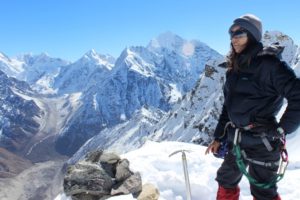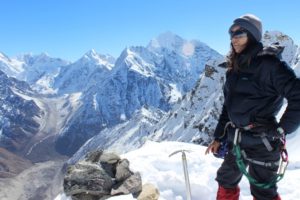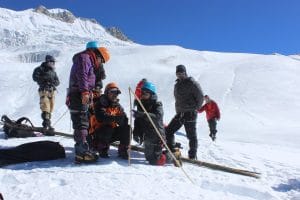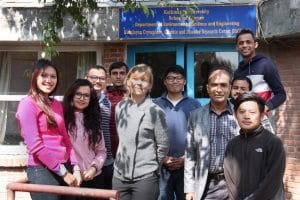
 Gunjan Silwal, 29, during a research expedition to Yala glacier.
Gunjan Silwal, 29, during a research expedition to Yala glacier.
On her desk, Gunjan Silwal is engrossed in her computer, analyzing glacier mass balance data, working on figures and graphs which to the untrained eye look rather like scribblings on a toddler’s drawing book. To the trained eye, however, these are essential records of how much mass has been added or lost over the years on Yala glacier. The one she is working on is for the annual mass balance of the glacier from 2014 to 2015.
When Gunjan is finally done with her analysis, she will begin to prepare for yet another field expedition to the glacier. Come April, Gunjan and her peers will head up to Yala glacier to collect spring data.
Gunjan, 29, joined the International Centre for Integrated Mountain Development (ICIMOD)’s Cryosphere Initiative in 2016 as a research associate. She has spent a substantial amount of her time on the glacier – often doing strenuous manual work such as installing and measuring stakes for mass balance monitoring, installing temperature loggers for permafrost studies, and measuring the discharge of glacier meltwater streams to better understand how glaciers in the Nepal Himalaya are responding to global climate change.
 Gunjan Silwal (centre) measuring stake data for glacier mass balance at Yala. Readings on stake measurements help researchers determine whether or not a given year has been a good one for the glacier.
Gunjan Silwal (centre) measuring stake data for glacier mass balance at Yala. Readings on stake measurements help researchers determine whether or not a given year has been a good one for the glacier.
“Water is one of the main sources of livelihood in Nepal and the HKH. It is empowering to learn about how climate change is impacting our main water reservoir,” she says. Her first time working on a glacier was in 2013, visiting Yala glacier as graduate student for a practical field data collection exercise.
“Before our practical field data collection exercise, Gunjan had never been above 3,000 metres, but that did not deter her from carrying out her task professionally,” says Tika Gurung, Gunjan’s colleague at ICIMOD, and fellow Kathmandu University (KU) alumni. “She is passionate about her work.”
ICIMOD’s contribution to Cryosphere research in the region
The Cryosphere Initiative of ICIMOD has been pioneering research on the impacts of climate change in the HKH, alongside building capacity in cryosphere research. A career in glaciology demands physical and mental strength and commitment. This involves hiking up to inaccessible glaciers in remote places, and spending weeks in the field well above 5,000 metres to collect data on glacier mass balance, snow, and meteorological and hydrological conditions. What the job requires is a zeal for understanding the process of climate change, and a knack for adventure.
Across the HKH, a vast glacierized expanse, there are only a few glaciologists from the region, and fewer women than men. To address the lack of experts from the region and also encourage gender balance in glacier research, ICIMOD has been playing a crucial role in providing a platform for women professionals.
Despite long working hours in high altitudes and exposure to harsh mountain conditions, more women from the region are taking up glaciology. Graduating in 2015, Gunjan Silwal is one of 23 young graduates of the MS by Research in Glaciology programme, a collaboration between ICIMOD and KU.
The MS programme is implemented under the Cryosphere Monitoring Programme (CMP), with funding provided by the Government of Norway. The programme provides scholarships for students from Nepal. Currently, seven students are enrolled in the programme, four of whom are supported by CMP funding.
“The main challenge is in selecting candidates for the course, because candidates need to be both academically sound and physically fit. Fieldwork in the high mountains is physically and mentally taxing,” says Associate Professor Rijan Bhakta Kayastha, coordinator of the MS programme.
 Rijan Bhakta Kayastha (PhD), coordinator for MS by Research programme (KU) second from right, and Anna Sinisalo (PhD), Programme Manager, Cryosphere Initiative, ICIMOD, with the current batch of MS by research students at KU.
Rijan Bhakta Kayastha (PhD), coordinator for MS by Research programme (KU) second from right, and Anna Sinisalo (PhD), Programme Manager, Cryosphere Initiative, ICIMOD, with the current batch of MS by research students at KU.
“Our research sites focus on two river basins currently. With increased human resource and experts, we could collaborate with organizations such as ICIMOD to monitor all the 19 glacierized river basins in Nepal” says Kayastha. KU is now working towards supporting more students from other countries in the region.
Since its inception in 2013, CMP has supported 93 women in cryosphere related trainings. The Cryosphere Initiative itself has come a long way from having no female researchers to now being led by a woman. The current ratio of female to male glaciologist stands at 5:8. ICIMOD is also working with a large group of international scientists, both men and women but Anna Sinisalo, Programme Coordinator for the Cryosphere Initiative at ICIMOD, believes that much can be done to encourage more women scientists, especially from the HKH, to develop careers in this field.
The initiative continues to make conscious efforts to involve more women in the programme through scholarships, training courses, and by promoting the participation of regional women professionals
“Our goal is to achieve sustainably and scientifically robust long-term monitoring programmes related to the cryosphere to better understand the importance of this resource to mountain communities, downstream populations, as well as the global community,” says Sinisalo.
Data measured and processed by Gunjan and her colleagues along with ICIMOD’s partners during and after the annual field expeditions contribute to global glacier mass balance datasets. Gunjan has also used such data for glacio-hydrological modelling of the Chamkhar Chu basin, Bhutan, to estimate the contributions of snow and glacier meltwater to rivers. The outcome of her work was presented at the American Geophysical Union (AGU) annual meet in December 2016.
“Glaciology in itself is a new science field in this region, and there is still a lot to do in terms of encouraging students to take up this course,” says Gunjan.
As a young researcher in glacier science, Gunjan Silwal sees herself working in the field of water security, contributing to long term monitoring and free access to data and supporting evidence-based decision making in the region.
This blog was originally written by Chimi Seldon and published on 22 March 2017 on the ICIMOD Cryosphere Knowledge Hub blog page. You can view it here.

